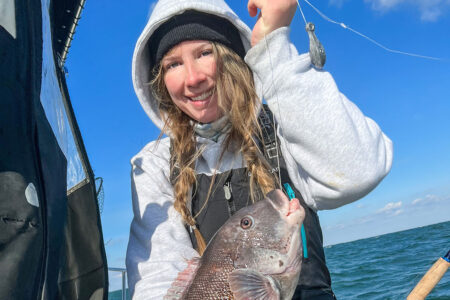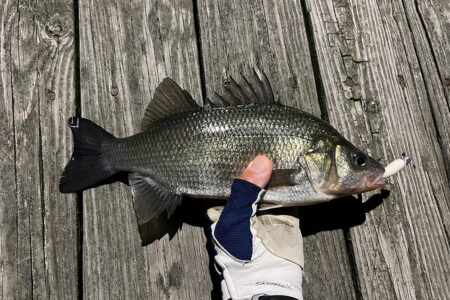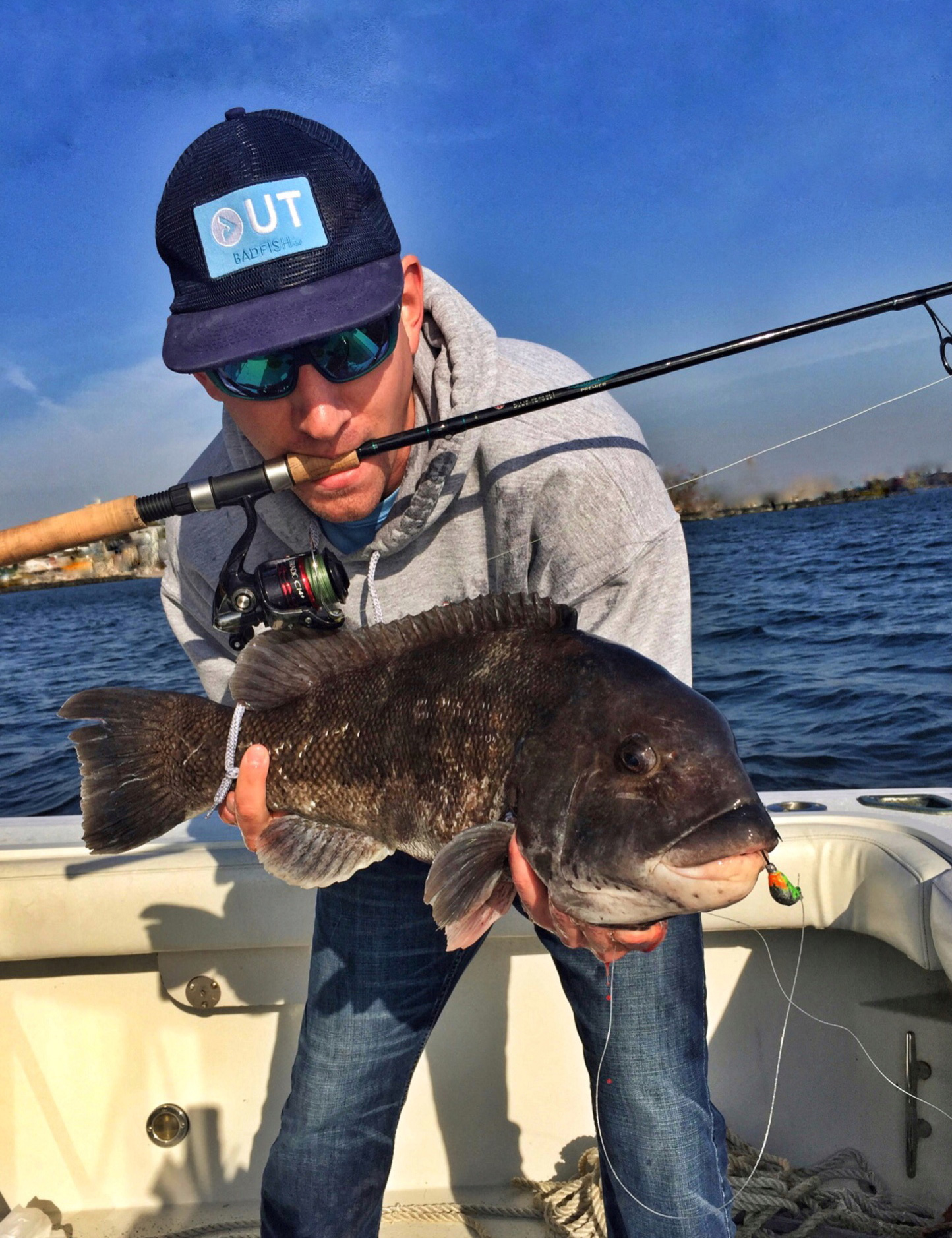
A crab is just a crab some say. Well not exactly, at least where fishing for jumbo blackfish are concerned. In fact, the difference between slamming a tub of bully white chins versus a pail with barely any keepers comes down to how you present those crusty crustaceans to the liking of the structure loving warriors. Therefore if tog fishing is on your agenda, it certainly wouldn’t hurt to read on and perhaps pick up a tip or two of how the tog specialists bait their hooks and consistently put slob tog in the box.
Meet the Crabs
Fiddler Crabs
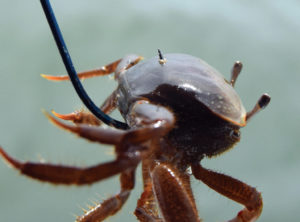 They are found living in burrows near the water’s edge feeding on decaying plant material present in salt marsh mud and sediment. Fiddler crabs are colonial, often living together in large clusters, traveling in groups of thousands and can stay out of the water in damp ground for months at a time. They also have a primitive lung, which enables them to live on land. Fiddler crabs are basically a one shot deal when targeting tog, therefore anglers must stay alert. The best way to bait these little critters is to run the hook right through the center of the crab from the bottom and up through the top shell, leaving the large claws intact. Sharp number 5 Mustad Virginia or 1/0 Gamakatsu Octopus hooks are ideal sizes and will not crush the bait in your hands as would larger size hooks.
They are found living in burrows near the water’s edge feeding on decaying plant material present in salt marsh mud and sediment. Fiddler crabs are colonial, often living together in large clusters, traveling in groups of thousands and can stay out of the water in damp ground for months at a time. They also have a primitive lung, which enables them to live on land. Fiddler crabs are basically a one shot deal when targeting tog, therefore anglers must stay alert. The best way to bait these little critters is to run the hook right through the center of the crab from the bottom and up through the top shell, leaving the large claws intact. Sharp number 5 Mustad Virginia or 1/0 Gamakatsu Octopus hooks are ideal sizes and will not crush the bait in your hands as would larger size hooks.
Green Crabs
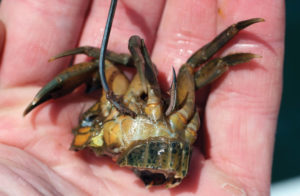 By far the most common and popular tog bait introduced by way of foreign ships back in the 1800’s and have since been a staple of bays and harbors up and down the Northeast Coast. Greenies come in many sizes and can be presented to a tog in many forms. They can be fished whole, cut or custom trimmed. All are successful depending on the likings of the tog. Just about any decent bait shop carries them throughout blackfish season and they can be purchased by the dozen or by a half or full bushel at a moderately fair price. They are easy to keep alive in a number of ways. They will live forever submerged in the water in a cage next to your boat. Throwing in a fish rack or two every so often will keep them frisky and happy. A burlap sack kept in a cool dark place and dunked in some cool saltwater every few days will keep them alive for a couple of weeks, as will a cooler. Again, a couple of filleted fish racks will keep them going. It’s a standard bait for most open and charter boats during tog season and can be an extremely effective bait in the right hands. Small greenies can be fished whole by placing a 3/0 to 4/0 super sharp Gamakatsu octopus hook through the back in between the last pair of legs. Larger crabs should be halved with either the legs or claw left intact or removed. Protrude the hook from the outside of the crab through the leg socket and out from another leg socket. Leaving a leg or the claw intact often entices the bite.
By far the most common and popular tog bait introduced by way of foreign ships back in the 1800’s and have since been a staple of bays and harbors up and down the Northeast Coast. Greenies come in many sizes and can be presented to a tog in many forms. They can be fished whole, cut or custom trimmed. All are successful depending on the likings of the tog. Just about any decent bait shop carries them throughout blackfish season and they can be purchased by the dozen or by a half or full bushel at a moderately fair price. They are easy to keep alive in a number of ways. They will live forever submerged in the water in a cage next to your boat. Throwing in a fish rack or two every so often will keep them frisky and happy. A burlap sack kept in a cool dark place and dunked in some cool saltwater every few days will keep them alive for a couple of weeks, as will a cooler. Again, a couple of filleted fish racks will keep them going. It’s a standard bait for most open and charter boats during tog season and can be an extremely effective bait in the right hands. Small greenies can be fished whole by placing a 3/0 to 4/0 super sharp Gamakatsu octopus hook through the back in between the last pair of legs. Larger crabs should be halved with either the legs or claw left intact or removed. Protrude the hook from the outside of the crab through the leg socket and out from another leg socket. Leaving a leg or the claw intact often entices the bite.
Hermit Crabs
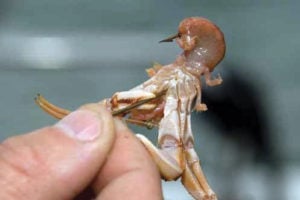 Also known as blackfish candy, and indeed a tog favorite, especially big tog. Their soft and gooey flesh is irresistible to blackfish, and unfortunately irresistible to sea bass, scup and cunners that also inhabit the tog grounds. I find that hermits are a must on reefs and wrecks when water temperatures are between 52 and 55 degrees and most of the other bottom dwellers have moved well offshore to warmer, deeper water. Serious toggers purchase them by the half or full bushel and keep them boat side caged and ready to go when called on. While some bait shops will carry them through the fall season, you may have to call a bait shop a day or two before heading out and order them. To properly hook hermit crabs, a firm smack with a hammer or a 10-ounce or bigger bank sinker on a solid flat surface will crack the shell, exposing the crab. Simply thread a number 3 Mustad Virginia or a 3/0 to 4/0 Gamakatsu Baitholder hook starting at the tip of the soft sac and push it through the center as if you were threading on a worm.Allow it to protrude though the hard shell, preferably on the head between the eyes. This will allow the crab to stay positioned and stable, and make the tog work for that irresistible soft sac.
Also known as blackfish candy, and indeed a tog favorite, especially big tog. Their soft and gooey flesh is irresistible to blackfish, and unfortunately irresistible to sea bass, scup and cunners that also inhabit the tog grounds. I find that hermits are a must on reefs and wrecks when water temperatures are between 52 and 55 degrees and most of the other bottom dwellers have moved well offshore to warmer, deeper water. Serious toggers purchase them by the half or full bushel and keep them boat side caged and ready to go when called on. While some bait shops will carry them through the fall season, you may have to call a bait shop a day or two before heading out and order them. To properly hook hermit crabs, a firm smack with a hammer or a 10-ounce or bigger bank sinker on a solid flat surface will crack the shell, exposing the crab. Simply thread a number 3 Mustad Virginia or a 3/0 to 4/0 Gamakatsu Baitholder hook starting at the tip of the soft sac and push it through the center as if you were threading on a worm.Allow it to protrude though the hard shell, preferably on the head between the eyes. This will allow the crab to stay positioned and stable, and make the tog work for that irresistible soft sac.
White Crab
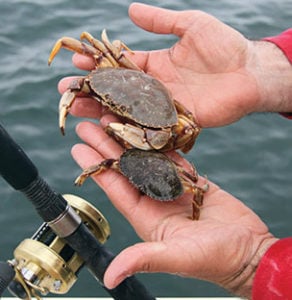 Also known as a stone or Jonah crab are the crab of the sharpies who consistently nail slob tog. They are a natural enemy of the blackfish and can be purchased by the bushel if you order them a few days before heading out at most bait shops. Plan on using them within a few days as they are difficult to keep alive. Keeping them cool in a cooler will keep their hearts beating for a few days. The larger white crabs can be halved and fished the same manner as green crabs. These gems are best fished whole on snafu rigs. The best method is to place a hook on each backside of the crab and with the sinker in hand, place a small crack on the top center of the crab to allow the secretion of the innards to leech out without killing the crab. This is the best of the best when double digit size blacks are in the neighborhood and this approach will certainly tempt even the most skittish tog.
Also known as a stone or Jonah crab are the crab of the sharpies who consistently nail slob tog. They are a natural enemy of the blackfish and can be purchased by the bushel if you order them a few days before heading out at most bait shops. Plan on using them within a few days as they are difficult to keep alive. Keeping them cool in a cooler will keep their hearts beating for a few days. The larger white crabs can be halved and fished the same manner as green crabs. These gems are best fished whole on snafu rigs. The best method is to place a hook on each backside of the crab and with the sinker in hand, place a small crack on the top center of the crab to allow the secretion of the innards to leech out without killing the crab. This is the best of the best when double digit size blacks are in the neighborhood and this approach will certainly tempt even the most skittish tog.
Sand or Mole Crab (Sand Flea)
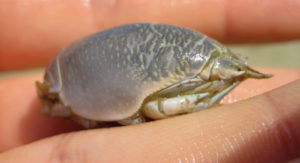 Although not commonly employed when it comes to blackfish, they are extremely effective, particularly from rock jetties that border ocean inlets and breachways. Mole Crabs are easy to catch. Raking along the water’s edge at low tide on most all ocean beaches up and down the coast will produce an easy day’s supply. Keeping them from perishing beyond a day would be challenging, therefore catching enough for a tide won’t let them go to waste. To hook this bait, thread the point up through the body above the tail and belly sac toward the head. Some anglers prefer to push the barb through the shell, while others prefer to poke only the hook point through the shell. Lightly hooking the crab will make it less likely to hang up on seaweed or rocks.
Although not commonly employed when it comes to blackfish, they are extremely effective, particularly from rock jetties that border ocean inlets and breachways. Mole Crabs are easy to catch. Raking along the water’s edge at low tide on most all ocean beaches up and down the coast will produce an easy day’s supply. Keeping them from perishing beyond a day would be challenging, therefore catching enough for a tide won’t let them go to waste. To hook this bait, thread the point up through the body above the tail and belly sac toward the head. Some anglers prefer to push the barb through the shell, while others prefer to poke only the hook point through the shell. Lightly hooking the crab will make it less likely to hang up on seaweed or rocks.
Shedder or Blue Claw Crab
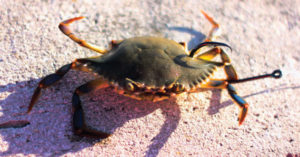 Shedder crabs are regular blue claw crabs that are close to shedding their shells and becoming soft shell crabs. An easy way to find shedders is to look for double back crabs swimming near the surface or holding on to pilings and bulkheads. A male crab will piggy-back a female shedder crab to protect her through the very vulnerable soft shell stage. The bottom crab is always a female and is always a shedder. A bait ready shedder can be peeled from its shell and cut up into small pieces of bait. What makes a shedder crab such a great bait, especially along the Mid-Atlantic States are the pheromones which is a chemical substance secreted by crabs and other creatures to attract each other. Once a crab sheds and becomes a soft shell, it is still a good bait, but it loses its pheromone potency and does not work as well as a peeler. Only a small piece of shedder crab is required for bait, because you are fishing with pheromones rather than meat.
Shedder crabs are regular blue claw crabs that are close to shedding their shells and becoming soft shell crabs. An easy way to find shedders is to look for double back crabs swimming near the surface or holding on to pilings and bulkheads. A male crab will piggy-back a female shedder crab to protect her through the very vulnerable soft shell stage. The bottom crab is always a female and is always a shedder. A bait ready shedder can be peeled from its shell and cut up into small pieces of bait. What makes a shedder crab such a great bait, especially along the Mid-Atlantic States are the pheromones which is a chemical substance secreted by crabs and other creatures to attract each other. Once a crab sheds and becomes a soft shell, it is still a good bait, but it loses its pheromone potency and does not work as well as a peeler. Only a small piece of shedder crab is required for bait, because you are fishing with pheromones rather than meat.
While not commonly used up north, some tog sharpies will go out of their way to employ blue crab as a top bait anytime during the season. These critters are typically readily available throughout most of the year, and can be found live at most tackle shops south of New Jersey and in most seafood stores. Be sure to request female crabs which are easily identified by the wide apron on their bellies. It is important to keep the crabs alive until they become tog food. Storing blue crabs directly on ice or in icy water will kill them. To keep them alive, spread several layers of newspaper or cardboard over of a layer of ice in the bottom of a cooler and place the crabs upright on the paper. Carefully spread a layer of wet newspaper over the crabs to help keep them moist, cool and happy. When baiting up, break off the claws first for easy handling. Blue crabs develop a nasty disposition when they are about to become lunch, and it will only take one good pinch to remind you if you forget. Pull off its back shell by lifting the edge of the shell with your thumb, and cut off all the legs up to the second knuckle, using a pair of bait-scissors. Once bait-worthy, cut the crab into two to four pieces depending on its size. Feed the hook through a leg or knuckle opening, and continue to feed the hook through the crab, until it pops out of the body exposing the barb. The orange, slimy goo inside the crab is what makes the female crabs so enticing, so if it washes out, replace your bait. Blue crabs are particularly tamper-resistant, and will tend to stay on the hook better than most other tog offerings.
Asian Crabs
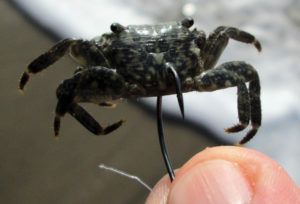 They are easily distinguishable from the green crab with their Chinese looking markings. They don’t grow much larger than the size of a quarter, making them excellent baits when used whole. They are very effective on rock jetties and rock piles along the coast. Most bait shops don’t stock them, however, like hermits and white crabs, some shops can track them down for you if you ask ahead of time. Those shops that do carry them, usually sell out within hours of receiving them. Most tog fishermen catch their own by flipping over rocks at low tide and catching them by hand. Asian crabs are best fished whole and alive and can easily be kept alive in a submerged fine mesh cage for the entire season. A filleted fish rack or two tossed into the cage every week or so will keep them healthy and happy. Just as with fiddler crabs, push the hook through the center of the crab starting at the bottom and through the top with the barb of the hook exposed. Super sharp 3/0 GamakatsuOctopus hooks or sharpenednumber 5, 4 or 3 Mustad Virginia hooks will get the job done.
They are easily distinguishable from the green crab with their Chinese looking markings. They don’t grow much larger than the size of a quarter, making them excellent baits when used whole. They are very effective on rock jetties and rock piles along the coast. Most bait shops don’t stock them, however, like hermits and white crabs, some shops can track them down for you if you ask ahead of time. Those shops that do carry them, usually sell out within hours of receiving them. Most tog fishermen catch their own by flipping over rocks at low tide and catching them by hand. Asian crabs are best fished whole and alive and can easily be kept alive in a submerged fine mesh cage for the entire season. A filleted fish rack or two tossed into the cage every week or so will keep them healthy and happy. Just as with fiddler crabs, push the hook through the center of the crab starting at the bottom and through the top with the barb of the hook exposed. Super sharp 3/0 GamakatsuOctopus hooks or sharpenednumber 5, 4 or 3 Mustad Virginia hooks will get the job done.
Rigging Up
Standard Rigs
They come in several styles and sizes. Keeping the rigs plain and simple and free of little gizmos will produce much better than any rig with clunkers that will scare away bully tog. Hooks connected to dropper loops a few inches from the sinker to as high as a foot above the sinker depending on the structure under and around the boat work very well. A general favorite of mine when fishing rocky lairs consists of approximately eight feet of 50-pound mono leader with a dropper loop tied 12-inches above the sinker. I’ll slip the dropper loop directly through the eye of a super sharp Gamakatsu 3/0 octopus hook, which allows for less twisting of the line equating to minimal spin of the baited rig, and quick penetration to an unsuspecting tog. I’ll also tie several of the same rigs with the dropper loop and hook 3 to 4 inches from the sinker for those low lying pieces. This particular rig can be used on most of the rock and wreck structure found in the Northeast.
Snafu Rigs
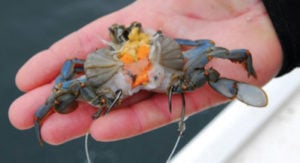 The snafu rig is used when fishing a whole crab, particularly, green, calico and white crabs. The concept is placing two hooks into a crab, giving the fishermen a better chance for a solid hook up when a blackfish attacks one of the sides of the crab. The snafu rig is preferably used on blackfish lairs that are not extremely sticky and is known to hold outsize togs. Knowledge of the piece of structure being fished and patience is paramount when employing a Snafu rig, otherwise standard blackfish rigs are a better choice in territory populated by average size fish. The rig consists of a pair of hooks snelled to both ends of a short piece of leader material. Centered between them is a small dropper loop which allows the snafu to be attached to a main leader. A Surgeons Knot is typically looped at the bottom holding the sinker, with a small dropper loop placed an inch or two above the Surgeons Knot. The Snafu rig is connected to the dropper loop. Snafu rigs are not suited to be fished an entire day or tide as they do come with some setbacks when fished improperly. Flaws such as whole crabs have a tendency to twist and knot the rig in strong current and can also cause the bait to sit unnaturally off the bottom, hampering its effectiveness. If you’re adamant about fishing the snafu through the hard tides, I suggest adding a barrel swivel to the leader before snelling the hooks onto the rig. Thread the barrel swivel onto the leader (approximately 18 to 20 inches) and tie it into the dropper loop in the center of the rig between the two snelled hooks. Tie the snafu’s barrel swivel directly to the leader via an Improved Clinch knot, running it up approximately 8 inches from the swivel and tying a large dropper loop to hold the sinker. Lastly, pull off another foot or two of leader, and tie another barrel swivel to the tag end. The addition of the barrel swivels will help eliminate rig twist, keeping the crab on the bottom and in the feeding zone.
The snafu rig is used when fishing a whole crab, particularly, green, calico and white crabs. The concept is placing two hooks into a crab, giving the fishermen a better chance for a solid hook up when a blackfish attacks one of the sides of the crab. The snafu rig is preferably used on blackfish lairs that are not extremely sticky and is known to hold outsize togs. Knowledge of the piece of structure being fished and patience is paramount when employing a Snafu rig, otherwise standard blackfish rigs are a better choice in territory populated by average size fish. The rig consists of a pair of hooks snelled to both ends of a short piece of leader material. Centered between them is a small dropper loop which allows the snafu to be attached to a main leader. A Surgeons Knot is typically looped at the bottom holding the sinker, with a small dropper loop placed an inch or two above the Surgeons Knot. The Snafu rig is connected to the dropper loop. Snafu rigs are not suited to be fished an entire day or tide as they do come with some setbacks when fished improperly. Flaws such as whole crabs have a tendency to twist and knot the rig in strong current and can also cause the bait to sit unnaturally off the bottom, hampering its effectiveness. If you’re adamant about fishing the snafu through the hard tides, I suggest adding a barrel swivel to the leader before snelling the hooks onto the rig. Thread the barrel swivel onto the leader (approximately 18 to 20 inches) and tie it into the dropper loop in the center of the rig between the two snelled hooks. Tie the snafu’s barrel swivel directly to the leader via an Improved Clinch knot, running it up approximately 8 inches from the swivel and tying a large dropper loop to hold the sinker. Lastly, pull off another foot or two of leader, and tie another barrel swivel to the tag end. The addition of the barrel swivels will help eliminate rig twist, keeping the crab on the bottom and in the feeding zone.
Blackfish Jigs
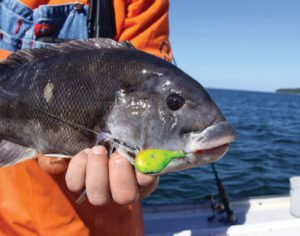 This is a relatively new niche compared to decades of hook, line and sinker. The advantages of the jig are hard to ignore. The bean-shaped design of the jig allows you to poke around every nook and cranny a tog may be lurking. Light spinning outfits give you the opportunity to cast around covering many yards of bottom increasing the odds of putting some quality fish in the box. The lima bean design and thin profile make the jig less likely to snag compared to a standard bait rig. Although blackfish jigs are available to 5-ounces, mostly in a green and orange pattern, most toggers favor jigs between one and three ounces in depths to 45 feet, and where the current moves less than two knots. While the entire array of crabs make for fine bait being applied to a jig, whole Asian, hermits and halved green crabs are tried and true. You can be the judge, bring a variety and see what works best.
This is a relatively new niche compared to decades of hook, line and sinker. The advantages of the jig are hard to ignore. The bean-shaped design of the jig allows you to poke around every nook and cranny a tog may be lurking. Light spinning outfits give you the opportunity to cast around covering many yards of bottom increasing the odds of putting some quality fish in the box. The lima bean design and thin profile make the jig less likely to snag compared to a standard bait rig. Although blackfish jigs are available to 5-ounces, mostly in a green and orange pattern, most toggers favor jigs between one and three ounces in depths to 45 feet, and where the current moves less than two knots. While the entire array of crabs make for fine bait being applied to a jig, whole Asian, hermits and halved green crabs are tried and true. You can be the judge, bring a variety and see what works best.
Hopefully these few suggestions will help put a bully white chin or two in the box this season. Better yet a photo is everlasting. So whether you venture on your own boat or head for one of the many open and charter boats targeting tog, please practice some self-restraint. Letting those big, old bulldogs go will allow tomorrow’s generation of anglers to enjoy this great fishery.


